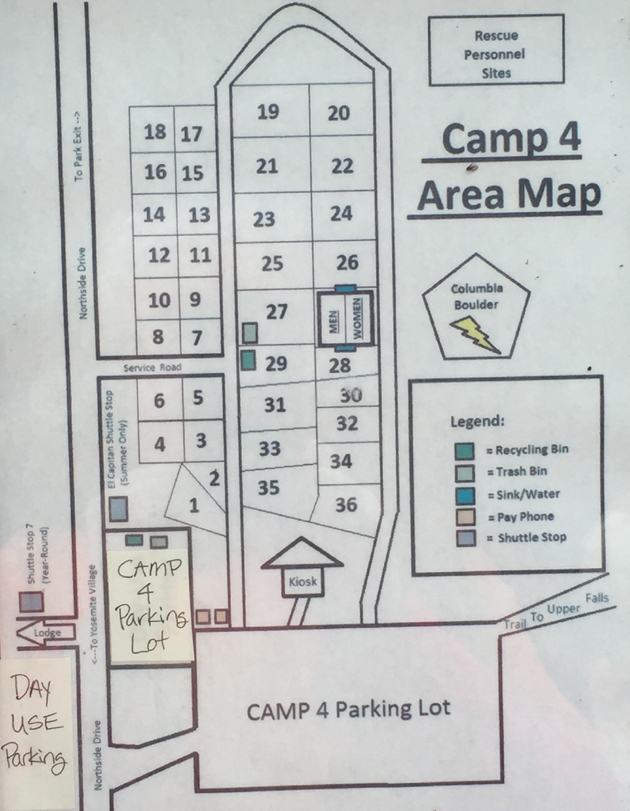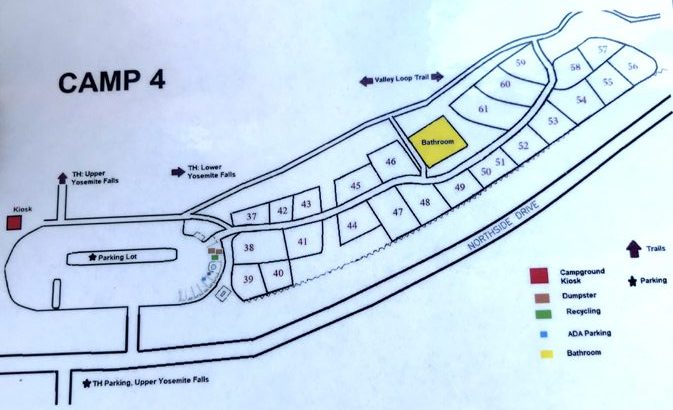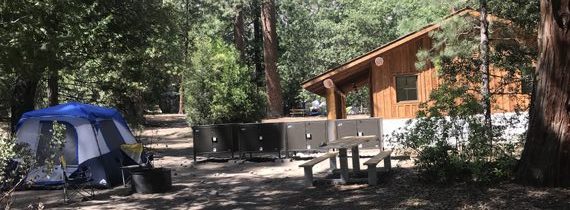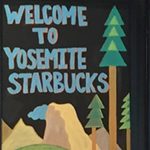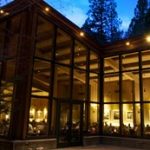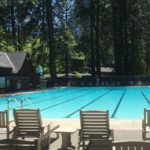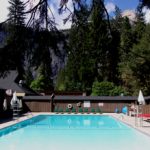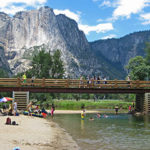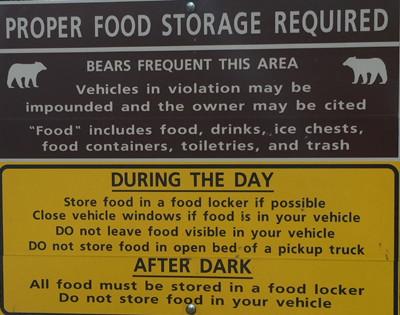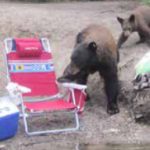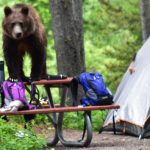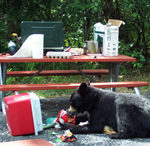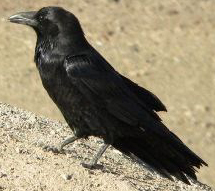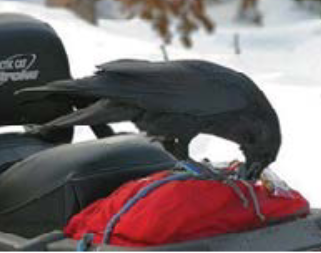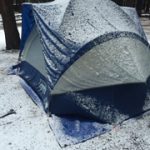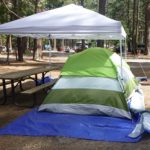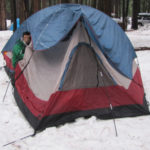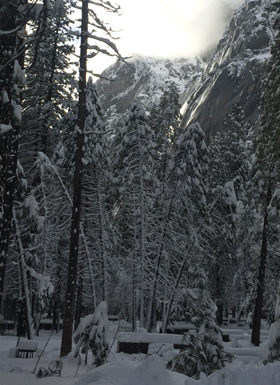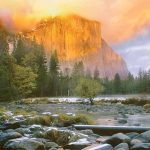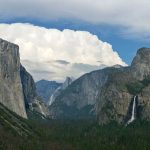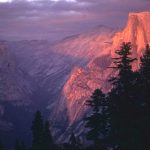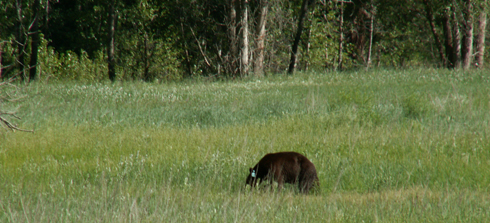Camp 4 in Yosemite Valley is located on Northside Drive ,
on the upper part of the mostly-one-way loop road through Yosemite valley.
Northside Drive runs almost the length of Yosemite Valley as a one-way road, from east to west, as outlined in red on the map below:
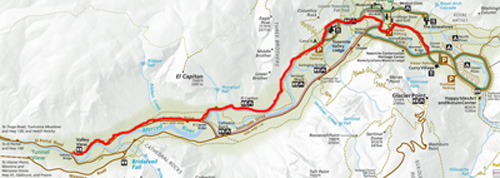
Where the red colored X is on the map below, there was once a driveway turning from Northside drive to the left into the Yosemite Valley Lodge. Go past it and be in the right hand lane to enter Camp 4.
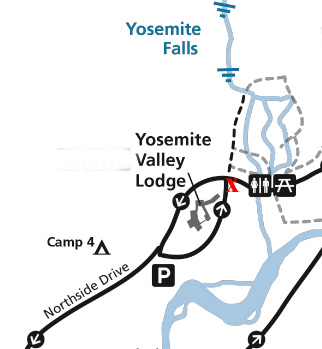
You can find a larger, more readable copy of the map of Yosemite valley below at:
https://www.nps.gov/yose/planyourvisit/maps.htm
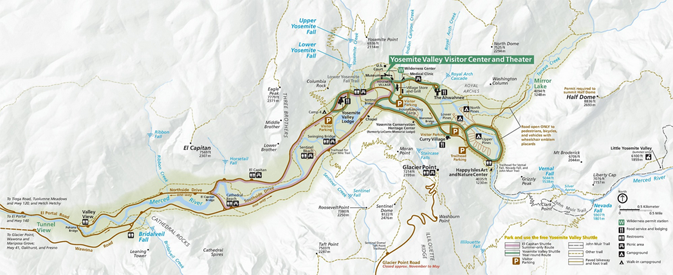
Camp 4 (sometimes written as Camp Four) has shared campsites and food lockers. The NPS has said: “Each campsite contains a fire pit (no grill), picnic table, and four shared food lockers [35″(D)x43″(W)x28″(H)], and is near a bathroom with drinking water and flushing toilets. . . People per site: A maximum of six people (including children) are allowed per campsite.’
Google maps has a 360 degree view
and a second view you can scroll around of the original campground section.
The first map below of the original Camp 4 campground has campsites #1- #36, restrooms, the trailhead for the Upper Yosemite Falls hike and the location of the largest boulder within the campground, Columbia Boulder, (or Big Columbia), which has the “world’s most famous boulder problem” – or – “the most difficult bouldering problem in the world,” the route named “Midnight Lightning.” Swan Slab is a bit north, off of this map, but you can find the location by using Google maps and searching for, you guessed it, Swan Slab.
The closest Yosemite Valley free shuttle bus stop, number seven, is across the road on the far left of this map below. It is NOT actually where the gray square on this first NPS map is, it is farther off the road a bit past the Yosemite Falls day use parking area, near Yosemite Valley Lodge building Laurel.
This original west side section is not always open all year, for example, in 2023 we read in the Yosemite Daily report:
“The west-side (sites 1-36) of Camp 4 will close for the season at noon on Monday, October 30.”
This second NPS map shows (new in 2021) campsites #37 – #61, the expanded parking lot ( capacity 130 vehicles) shower house and restrooms
(the yellow square labeled Bathroom on the map below).
The check-in kiosk is the red square to the left of the parking lot in this map.
The showers are in separate spaces, from the men’s and women’s restrooms with sinks/toilets. You will find this sign on the door:
BUT the showers have often not been listed on the official NPS website about Camp Four and you should confirm for yourself if you will be able to use one.
The new section of the campground has more foot traffic through it of people coming and going from the Yosemite Falls day use parking lot and Yosemite Lodge to eastern Yosemite valley destinations than the original Camp 4 campground section has.
Some of the campsites are right next to the restrooms with shower house (the yellow square labeled Bathroom on the map above):
and some of the campsites are right on Northside drive with traffic noise (the white SUV in the background is on the road):
Camp 4 is open all year:

Be careful turning into the parking lot from Northside Drive, as many pedestrians do not use the crosswalks and walk in the middle of the roadway intersection.
People parking at the Camp 4 campground parking lot MUST have a Camp 4 camp space permit, 24 hours a day, or they will be towed.
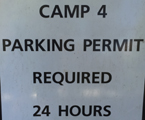
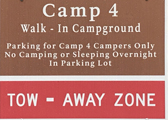
If you have more vehicles than spaces allowed, you can park them across Northside Drive at the Yosemite Falls (Yosemite Lodge) day use parking lot.
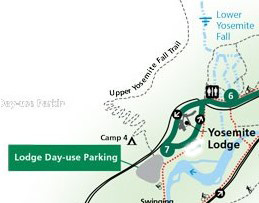
Yosemite Falls day use parking has 10 level 2, 11 kW/h Electric Vehicle (EV) charging stations.
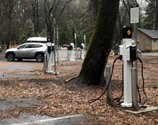
![]()
And at the Lodge, find various restaurants and stores.
see: Yosemite valley restaurants, coffee bars, cafeterias, food service and groceries
swimming in Yosemite including thunderstorms, bacteria in the water, safety issues, favorite beaches, swimming pools with lifeguards, places you should not swim.
The NPS has said:
Camp 4 (Camp Four) “is extremely popular; it’s very difficult to get a spot.”
“Reservations and Registration
Seasons
Mid-April through October
From April 29, 2025 through sometime in September or October, campsites will be available only by reservation via Recreation.gov (https://www.recreation.gov/camping/campgrounds/10004152) one week in advance of your arrival date. Up to 6 people can be registered for a site per each reservation transaction. The camping fee is $10 per person per night.
November to mid-April
Camp 4 operates on a first-come, first-served basis, usually until sometime in April. The campground may fill early in the morning every day in spring and fall if weather is nice. The camping fee is $10 per night.
Note that early in the year there can be changes in the registration system:
https://www.nps.gov/yose/planyourvisit/horsetailfall.htm
Camping Limit
There is a 30-night camping limit within Yosemite National Park in a calendar year; however, May 1–September 15, the camping limit in Yosemite is 14 nights, and only seven of those nights can be in Yosemite Valley or Wawona.
Parking is available adjacent to the campground (it’s a very short walk to the campsites). A parking permit is required from spring through fall. You will receive a free parking permit upon registering. . .”
“From sometime in April to sometime in October, reservations are required (available one week in advance). From October to sometime in April, the campground is open on a first-come, first-served basis and visitors self-register for a site upon arrival. A ranger may be onsite to help register campers. Space is available on a per-person basis and you can register/reserve for up to the maximum stay limit.”
The Camp 4 kiosk to check in at and get a campsite assignment (or to self register at some times of some years) is shown on both maps above. As you enter the campground parking lot it is to your left. In the windows you might find instructions for self-registration, a list of pre-booked campsite assignments, a sign that explains how Camp 4 Registered Guests can get access to the showers, campground rules and regulations worth going over with all the people in your group as many of them are different than the other campgrounds.
In the photo below, here is the view of the kiosk as seen from the parking lot:

All of the above can change with little notice. Official details from Yosemite National Park are at:
https://www.nps.gov/yose/planyourvisit/camp4.htm
– – – – – – – – – – – – – – – – – – – – – – – – – – – – – – – – – – – – – – – – – – – – – – – – – – – – – – – – – –
(From the park website: “Within Yosemite National Park, you may not sleep in your car or RV except in a campsite that you’re registered to stay in (except at Camp 4, where sleeping in cars is not allowed because it’s a walk-in campground). Sleeping in your car along the side of the road is also not allowed.”)
The park notes: “Camp 4 is listed on the National Register of Historic Places because of its nationally significant role in the development of rock climbing as a sport.”
There is fascinating reading on how Yosemite climbers can avoid injuries/stay alive, by Yosemite Search and Rescue (SAR) Ranger John Dill, (including sections on environmental dangers, descents, big wall bivouacs, unplanned bivouacs, loose rock, climbing unroped, leading, falling, learning to lead, the belay chain, helmets, states of mind, rescues, and risks, responsibility and the limits of climbing), at: Staying Alive
and read about climbing regulations, the reasons behind them and practical advice on how to follow the rules, including fixed ropes, permits and sleeping on big walls, food storage, trash and human waste while climbing, bouldering, slacklining, and bolting ethics at: https://www.nps.gov/yose/planyourvisit/climbing_regulations.htm
(Grand Teton National Park) Jenny Lake Climbing Rangers advised climbers:
Be Courteous. Let faster parties pass on climbing routes when safe to do so.
Get away from it all! Choose routes that are less popular to help alleviate overcrowding. Get an early start on climbs that are popular.
and they offer more details about how climbers can leave no trace at:
https://tetonclimbingethics.blogspot.com/
and more on Leave No Trace is here
https://www.nps.gov/yose/planyourvisit/climbingclosures.htm
Scroll around the almost 3,000 foot El Capitan Dawn Wall to look up close at climbers, a base camp of tents secured to the rock and follow their ropes during a 2015 free climb:
https://www.nytimes.com/interactive/2015/01/14/sports/the-dawn-wall-up-close.html
![]()
https://www.nps.gov/yose/planyourvisit/climbingpermits.htm
said, in mid 2024:
“A wilderness climbing permit is required for all overnight big wall climbs. Permits for climbers are available by self-registration, are free, and there are no quotas or limits on the number of permits available. The permit system helps climbing rangers better understand use patterns on big walls. It will also increase compliance with existing regulations (e.g., proper disposal of waste) and minimize impacts to wilderness character through improved education.
Permits are available by self-registration (24 hours per day/7 days per week) near El Capitan Bridge at a kiosk near the food lockers. Permits are also available near El Capitan Bridge (look for a kiosk near the food lockers). Pick up your permit the day before or day of the start of your overnight climb.
During the busy season, climbing rangers are available at the Ask-A-Ranger climber program at El Capitan Bridge from 12:30 pm to 4:30 pm for more in-depth big wall leave no trace and climbing technique advice, safety tips, and route condition information.”
– – – – – – – – – – – – – – – – – – – – – – – – – – – – – – – – – – – – – – – – – – – – – – – – – – – – – – – – – –
Setting your car alarm will not keep bears from getting into your car, but it can wake up everyone in the vicinity.
At bears you will find:
links to general info about bears,
then practicalities of camping and backpacking around bears, (Food Storage , what to do if you see a bear, how bears get into cars, info for backpackers) and lots of stories about bears getting into cars, tents, camps, etc., mostly geared towards De Anza College Outdoor Club trips around bears in California (especially Yosemite National Park) and Grand Teton National Park.
And the answer to the question:
Why don’t the rangers just move the problem bears?
and the question:
How can I keep a bear out of my campsite? (You can’t, but you can almost always keep it out of your food.)
__________________________________________________
Yosemite all-year resident Ravens are bigger than a Crow you might see at home. Ravens are 24 inches long and have a wingspan of 53 inches, Crows are 17.5 inches long and have a wingspan of 39 inches).
Ravens will take any food you leave unattended on a picnic table. Keeping food within arm’s reach is a wise idea at each of the picnic areas, hotels and campgrounds. The park warns: “If your food is stored improperly, you will be cited for improper food storage (fine of up to $5,000).” See also an index to over a dozen park webpages with park laws, rules, regulations and policies.
Ravens want to get into your gear, and some have figured out how to get into day packs (they can unzip or unfasten many different kinds of buckles and latches)
or . . . a bag tied onto a motorcycle:
I suggest you stay with gear you tied on to your vehicle or in an open truck bed until it can get stored properly from animals / birds.
Notes on preventing bears from breaking into your vehicle are at bears.
A squirrel robbing a pack you set down for just a moment may bite or pass disease:
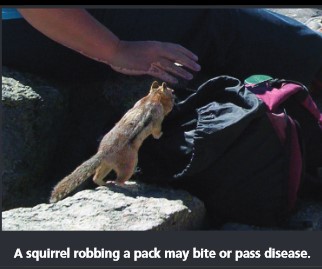
And for more choices of where to stay overnight in Yosemite Valley in Yosemite National Park (heated or unheated wood floored, canvas sided and roofed tent cabin / wood walled cabin without a bath / cabin with a bath / various designs of hotel rooms or campsites, see Yosemite overnight accommodations.
People climb over barriers meant to protect them, or try to swim above waterfalls and as a result slide over waterfalls in Yosemite. fatal, near fatal or close call incidents/accidents in camping, backpacking, climbing and mountaineering has press releases about them.
Cell phones in the wilderness has advice on how/when to use a cell phone to contact 911 in the wilderness and a warning about interference between cell phones, iPods and avalanche beacons.
You can’t always expect a helicopter rescue
They were only taking a selfie
Thunderstorm and lightning safety includes a warning about not using your cell phone or IPod during a storm.
There are crucial things wrong with each of these tents.
Don’t buy a cheap tent has reasons why and more examples of tents to NOT bring.
Below is a photo taken in December when the campground is not always as full as it is in warmer months.
and here in February when Camp 4 was closed due to falling trees after a major snowstorm, you can see snow covered bearboxes and picnic tables at the bottom of the picture
and here the view of Half Dome from the Camp 4 parking lot:
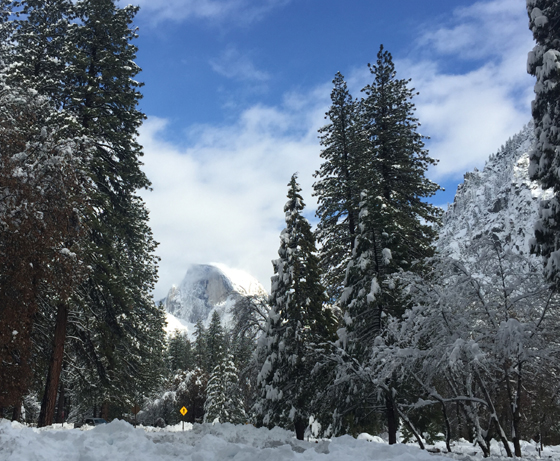
Where were they when they got that great picture in Yosemite?
Where is the best place to take a photo that looks like the one on a Yosemite postcard or t-shirt I just bought?
Places to take photos of Half Dome, Bridalveil Fall, El Capitan, Yosemite Falls and Staircase Falls.
for Yosemite Valley, Yosemite National Park, California https://pubs.usgs.gov/sir/2014/5129/pdf/sir2014-5129.pdf
We read, in that document: “individual, fragmental-type rock falls (herein referred
to simply as “rock falls”) deposit rock debris on talus slopes, with some rock falls depositing “outlying” boulders beyond the edge of talus slopes. Outlying boulder deposition may occur, for example, when boulders have sufficient bouncing or rolling energy such that they do not stop earlier on the talus” outlying boulders ” . . .as large
as approximately 100,000 m3 (cubic meters) in volume”.
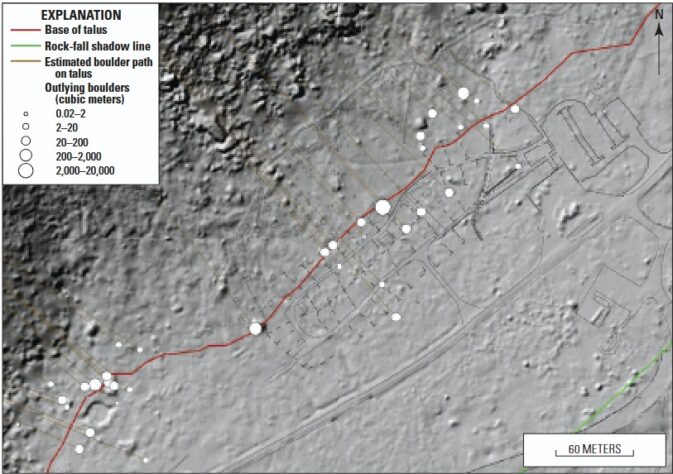
Above see outlying boulders (white circles) at part of Camp 4.
(Camp 4 includes Columbia Boulder (with the Midnight Lightning route)
See a Google Maps view of Columbia Boulder and scroll slightly to the right to see a person standing near the boulder to get an idea of the size.

The Yosemite National Park rangers would like you to call them
if you see a bear in Yosemite,
no matter where it is or what it is doing.
Since 2003 there has been a note in the Yosemite Guide: “REPORT ALL BEAR SIGHTINGS! To report bear sightings, improper food storage, trash problems, and other bear-related problems, leave a message for the Bear Management team at: 1 (209) 372-0322. Your call can be made anonymously.”
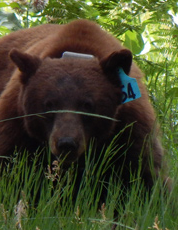
If you can, in all the excitement, try to notice if the bear has a tag (usually on the ear), the color of the tag and if possible, the number on it (the tag is large enough that with a telephoto lens you should be able to read the number).
The NPS notes: “Tagged, or radio collared, bears do not mean the bear is a “bad” bear. Tagging bears is done for better monitoring, and the ear tag color is completely random, used to help quickly identify a bear.”
From the Yosemite Daily Report newspaper:
“It is extremely important to remember to yell at bears that are in and around development, even if they are foraging on natural food. Though it is very tempting to get close for a picture, or just to watch these incredible animals, it is important not to give into this urge. Yelling at them if they are in residential areas or near people is critical to keep bears natural fear of humans. Giving bears plenty of space. When bears become too comfortable around people, they will often start causing damage to structures and vehicles, or will even become too bold around people, creating safety concerns.”
And the Yosemite Daily Report also said:
“Scare bears when you see them. . . in developed areas- Yell like you mean it!
Make as much noise as possible, try waving your arms, stomping your feet
or anything to make you look intimidating and to get the bear to run away.
We know it’s fun to see bears and it can feel mean to scare them,
but this is a simple way to truly help save a bear’s life.”



——————————————————————-
The author of this webpage, (written for my students), does not give any warranty, expressed or implied, nor assume any legal liability or responsibility for the accuracy, completeness, or usefulness of any information, product, or process included in this website or at websites linked to or from it. Users of information from this website assume all liability arising from such use.

